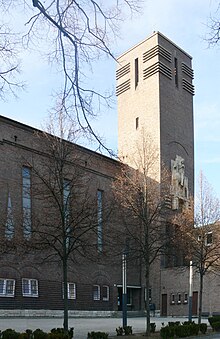Hugo locks
Hugo Schlösser (born May 30, 1874 in Ratingen , † June 19, 1967 in Stuttgart ) was a German architect .
Life
Hugo Schlösser came from a family of architects, his father Johannes Schlösser was a master builder . He and his wife Marie Lancet-Reinhardt , who came from Stuttgart, had a son, Gerhart (* 1908), who, with a doctorate in law, was Secretary General of the Council of Europe in Strasbourg .
Initially, Schlösser worked in Düsseldorf and Munich. His time in Munich was shaped by practical work with the renowned Munich architect Max Littmann . He then studied at the Technical University of Stuttgart and became a member of the Corps Teutonia Stuttgart . In 1903, after passing the 2nd state examination, he was appointed government architect ( assessor in public building management) and worked in architecture offices in Frankfurt am Main and Munich.
In 1906 he opened his own office in Stuttgart and associated in 1908 with another successful architect, Johann Weirether . During the extensive creative period of the two, between 1910 and 1913, the construction of the Villa Reitzenstein in Stuttgart , today the official seat of the State Ministry of Baden-Württemberg and the respective Prime Minister, took place . With his first church building, Schlösser was on December 2, 1910 by the cath. Parish in Aalen commissioned. He planned and built the Salvatorkirche Aalen , in the neo-renaissance style. It was consecrated on November 10, 1913 by Bishop Keppler and celebrates the 100th anniversary of consecration on November 10, 2013. In 1921 they also built the Villa Levi , a residential building in the north of Stuttgart, for Max Levi , co-owner of the nationally known shoe factory Salamander ( Kornwestheim ) . In 1923, Schlösser built a villa in the east of Heilbronn for Carl Emanuel Knorr , CEO of the Knorr food company . In addition to other villas in favored hillside locations in the city of Stuttgart, Schlösser also built the Bergkirche in Stuttgart-Degerloch (Assumption of Mary, 1927) and St. Clemens Church in Stuttgart-Botnang (1933) together with Weirether . Without a partner, Schlösser planned and managed the extension of the chapel for Matthias Grünewald's Madonna picture to the parish church of the Coronation of Mary in Bad Mergentheim-Stuppach in 1930/31 . The order also included the creation of a stone altar with an anti-theft device for the valuable panel painting. He also led the renovation of the Eberhardskirche , the Catholic city church in Stuttgart, and its reconstruction after the Second World War . In 1955, Schlösser was awarded the title of professor .
Building material
The designs regularly focus on the structure of the regional material: colored lime plaster, artificial stone , Maulbronn sandstone , Cannstatt travertine , paving clinker, copper sheet and, for example, spruce wood.
literature
- Christine Breig: The construction of villas and country houses in Stuttgart 1830–1930. Hohenheim Verlag, Stuttgart and Leipzig 2000, ISBN 3-89850-964-8 , p. 534.
Individual evidence
- ^ Address list of the Weinheimer SC. Darmstadt 1928, p. 294.
- ↑ Deutsche Bauzeitung , Volume 37, 1903, No. 37 (from May 9, 1903), p. 244. ( Personal news section )
- ↑ Architect of high standing. On the death of Professor Hugo Schlösser. In: Stuttgarter Zeitung of June 22, 1967
- ↑ catholic-kirche-aalen.de/salvator
- ↑ Villa Levi exterior view
- ↑ Villa Levi interior view
- ↑ Documentation of the construction and renovation history of the Catholic Church of the Assumption in Degerloch
- ↑ St. Clemens Church - image
- ↑ Gottlieb Merkle: Church building in transition. The basics of church building in the 20th century and its development in the Rottenburg diocese , Schwabenverlag 1973, ISBN 3-7966-0456-0 , p. 65.
- ↑ Richard Wolfgang Schmid: The restoration of the Stuppacher Madonna . In: Die Denkmalpflege 5/33 (1931), pp. 185–187; Paul Rueß: Our Lady of Stuppach , Bad Mergentheim 3rd supplemented edition, no year [between 1946 and 1952], pp. 30–35
- ↑ Obituary. In: Stuttgarter Zeitung of June 22, 1967; Gottlieb Merkle: Church construction in transition. The basics of church building in the 20th century and its development in the Rottenburg diocese , p. 67
- ↑ Church renovations
| personal data | |
|---|---|
| SURNAME | Locks, Hugo |
| BRIEF DESCRIPTION | German architect |
| DATE OF BIRTH | May 30, 1874 |
| PLACE OF BIRTH | Ratingen |
| DATE OF DEATH | June 19, 1967 |
| Place of death | Stuttgart |

